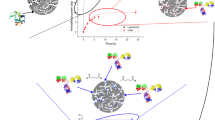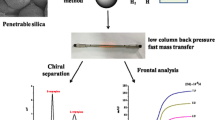Abstract
An on-column approach for protein entrapment was developed to immobilize alpha1-acid glycoprotein (AGP) for drug-protein binding studies based on high-performance affinity chromatography. Soluble AGP was physically entrapped by using microcolumns that contained hydrazide-activated porous silica and by employing mildly oxidized glycogen as a capping agent. Three on-column entrapment methods were evaluated and compared to a previous slurry-based entrapment method. The final selected method was used to prepare 1.0 cm × 2.1 mm I.D. affinity microcolumns that contained up to 21 (±4) μg AGP and that could be used over the course of more than 150 sample applications. Frontal analysis and zonal elution studies were performed on these affinity microcolumns to examine the binding of various drugs with the entrapped AGP. Site-selective competition studies were also conducted for these drugs. The results showed good agreement with previous observations for these drug-protein systems and with binding constants that have been reported in the literature. The entrapment method developed in this study should be useful for future work in the area of personalized medicine and in the high-throughput screening of drug interactions with AGP or other proteins.

On-column protein entrapment using a hydrazide-activated support and oxidized glycogen as a capping agent





Similar content being viewed by others
References
Cohen LH, Nicoll-Griffith DA. Plasma protein binding methods in drug discovery and development: bioanalysis. In: Lyubimov AV, editor. Encyclopedia of drug metabolism and interactions. Hoboken: Wiley; 2012. p. 657–74.
Hage DS, Anguizola J, Barnaby O, Jackson A, Yoo MJ, Papastavros E, et al. Characterization of drug interactions with serum proteins by using high-performance affinity chromatography. Curr Drug Metab. 2011;12:313–28.
Kratochwil NA, Huber W, Muller F, Kansy M, Gerber PR. Predicting plasma protein binding of drugs: a new approach. Biochem Pharmacol. 2002;64:1355–74.
Vuignier K, Guillarme D, Veuthey JL, Carrupt PA, Schappler J. High performance affinity chromatography (HPAC) as a high-throughput screening tool in drug discovery to study drug-plasma protein interactions. J Pharm Biomed Anal. 2013;74:205–12.
Hage DS. High-performance affinity chromatography: a powerful tool for studying serum protein binding. J Chromatogr B. 2002;768:3–30.
Ceciliani F, Pocacqua V. The acute phase protein α1-acid glycoprotein: a model for altered glycosylation during diseases. Curr Protein Pept Sci. 2007;8:91–108.
Israili ZH, Dayton PG. Human alpha-1-glycoprotein and its interactions with drugs. Drug Metab Rev. 2001;33:161–235.
Tesseromatis C, Alevizou A, Tigka E, Kotsiou A. Acute-phase proteins: alpha-1-acid glycoprotein. In: Veas F, editor. Acute phase proteins—regulation and functions of acute phase proteins. Rijeka: InTech; 2011. p. 247–60.
Goolkasian DL, Slaughter RL, Edwards DJ, Lalka D. Displacement of lidocaine from serum α1-acid glycoprotein binding sites by basic drugs. Eur J Clin Pharmacol. 1983;25:413–7.
Routledge PA, Barchowsky A, Bjornsson TD, Kitchell BB, Shand DG. Lidocaine plasma protein binding. Clin Pharmacol Ther. 1980;27:347–51.
Hanada K, Ohta T, Hirai M, Arai M, Ogata H. Enantioselective binding of propranolol, disopyramide, and verapamil to human α1-acid glycoprotein. J Pharm Sci. 2000;89:751–7.
Freilich DI, Giardina EG. Imipramine binding to alpha-1-acid glycoprotein in normal subjects and cardiac patients. Clin Pharmacol Ther. 1984;35:670–4.
Albani F, Riva R, Contin M, Baruzzi A. Stereoselective binding of propranolol enantiomers to human α1-acid glycoprotein and human plasma. Br J Clin Pharmacol. 1984;18:244–6.
Kaliszan R, Nasal A, Turowski M. Binding site for basic drugs on α1-acid glycoprotein as revealed by chemometric analysis of biochromatographic data. Biomed Chromatogr. 1995;9:211–5.
Piafsky KM, Borga O. Plasma protein binding of basic drugs. II. importance of alpha1-acid glycoprotein for interindividual variation. Clin Pharmacol Ther. 1977;22:545–9.
Lai CM, Moore P, Quon CY. Binding of fosphenytoin, phosphate ester pro drug of phenytoin, to human serum proteins and competitive binding with carbamazepine, diazepam, phenobarbital, phenylbutazone, phenytoin, valproic acid or warfarin. Res Commun Mol Pathol Pharmacol. 1995;88:51–62.
Kim Y, Choi K, Jung J, Park S, Kim PG, Park J. Aquatic toxicity of acetaminophen, carbamazepine, cimetidine, diltiazem and six major sulfonamides, and their potential ecological risks in Korea. Environ Int. 2007;33:370–5.
Herve F, Gomas E, Duche JC, Tillement JP. Evidence for differences in the binding of drugs to the two main genetic variants of human α1-acid glycoprotein. Br J Clin Pharmacol. 1993;36:241–9.
Leow KP, Wright AW, Cramond T, Smith MT. Determination of the serum protein binding of oxycodone and morphine using ultrafiltration. Ther Drug Monit. 1993;15:440–7.
Urien S, Albengres E, Pinquier JL, Tillement JP. Role of alpha-1 acid glycoprotein, albumin, and nonesterified fatty acids in serum binding of apazone and warfarin. Clin Pharmacol Ther. 1986;39:683–9.
Urien S, Albengres E, Zini R, Tillement JP. Evidence for binding of certain acidic drugs to α1-acid glycoprotein. Biochem Pharmacol. 1982;31:3687–9.
Urien S, Bree F, Testa B, Tillement JP. pH-dependence of warfarin binding to α1-acid glycoprotein (orosomucoid). Biochem J. 1993;289:767–70.
Nakagawa T, Kishino S, Itoh S, Sugawara M, Miyazaki K. Differential binding of disopyramide and warfarin enantiomers to human α1-acid glycoprotein variants. Br J Clin Pharmacol. 2003;56:664–9.
Maruyama T, Furuie MA, Hibino S, Otagiri M. Comparative study of interaction mode of diazepines with human serum albumin and α1-acid glycoprotein. J Pharm Sci. 1992;81:16–20.
Frostell-Karlsson A, Remaeus A, Roos H, Andersson K, Borg P, Hamalainen M, et al. Biosensor analysis of the interaction between immobilized human serum albumin and drug compounds for prediction of human serum albumin binding levels. J Med Chem. 2000;43:1986–92.
Amini A, Westerlund D. Evaluation of association constants between drug enantiomers and human α1-acid glycoprotein by applying a partial-filling technique in affinity capillary electrophoresis. Anal Chem. 1998;70:1425–30.
Mallik R, Xuan H, Guiochon G, Hage DS. Immobilization of α1-acid glycoprotein for chromatographic studies of drug-protein binding II. correction for errors in association constant measurements. Anal Biochem. 2008;376:154–6.
Mallik R, Xuan H, Hage DS. Development of an affinity silica monolith containing α1-acid glycoprotein for chiral separations. J Chromatogr A. 2007;1149:294–304.
Xuan H, Hage DS. Immobilization of α1-acid glycoprotein for chromatographic studies of drug-protein binding. Anal Biochem. 2005;346:300–10.
Xuan H, Joseph KS, Wa C, Hage DS. Biointeraction analysis of carbamazepine binding to α1-acid glycoprotein by high-performance affinity chromatography. J Sep Sci. 2010;33:2294–301.
Singh SS, Mehta J. Measurement of drug-protein binding by immobilized human serum albumin-HPLC and comparison with ultrafiltration. J Chromatogr B. 2006;834:108–16.
Hermanson GT, Mallia AK, Smith PK. Immobilized affinity ligand techniques. San Diego: Academic; 1992.
Besanger TR, Brennan JD. Entrapment of membrane proteins in sol–gel derived silica. J Sol–gel Sci Techn. 2006;40:209–25.
Keeling-Tucker T, Brennan JD. Fluorescent probes as reporters on the local structure and dynamics in sol–gel-derived nanocomposite materials. Chem Mater. 2001;13:3331–50.
Vera-Avila LE, Garcia-Salgado E, de Llasera Garcia MP, Pena-Alvarez A. Binding characteristics of bovine serum albumin encapsulated in sol–gel glasses: an alternative for protein interaction studies. Anal Biochem. 2008;373:272–80.
Jackson AJ, Xuan H, Hage DS. Entrapment of proteins in glycogen-capped and hydrazide-activated supports. Anal Biochem. 2010;404:106–8.
Kim HS, Hage DS. Immobilization methods for affinity chromatography. In: Hage DS, editor. Handbook of affinity chromatography. 2nd ed. Boca Raton: CRC Press; 2006. p. 35–78.
Bi C, Jackson A, Vargas-Badilla J, Li R, Rada G, Anguizola J, Pfaunmiller E, Hage DS. Entrapment of alpha1-acid glycoprotein in high-performance affinity columns for drug-protein binding studies. J Chromatogr B. In press.
Monton MRN, Forsberg EM, Brennan JD. Tailoring sol–gel-derived silica materials for optical biosensing. Chem Mater. 2012;24:796–811.
Jackson AJ, Anguizola J, Pfaunmiller E, Hage DS. Use of entrapment and high-performance affinity chromatography to compare the binding of drugs and site-specific probes with normal and glycated human serum albumin. Anal Bioanal Chem. 2013;405:5833–41.
Zheng X, Li Z, Beeram S, Podariu M, Matsuda R, Pfaunmiller E, et al. Analysis of biomolecular interactions using affinity microcolumns: a review. J Chromatogr B. 2014;968:49–63.
Ruhn PF, Garver S, Hage DS. Development of dihydrazide-activated silica supports for high-performance affinity chromatography. J Chromatogr A. 1994;669:9–19.
Yoo MJ, Hage DS. Evaluation of silica monoliths in affinity microcolumns for high-throughput analysis of drug-protein interactions. J Sep Sci. 2009;32:2776–85.
Vargas-Badilla J. Applications of high performance affinity chromatography with high capacity stationary phases made by entrapment. PhD Dissertation, University of Nebraska-LIncoln, Lincoln, NE. 2015.
Sobansky MR, Hage DS. Identification and analysis of stereoselective drug interactions with low-density lipoprotein by high-performance affinity chromatography. Anal Bioanal Chem. 2012;403:563–71.
Tweed SA, Loun B, Hage DS. Effects of ligand heterogeneity in the characterization of affinity columns by frontal analysis. Anal Chem. 1997;69:4790–8.
Bi C, Zheng X, Hage DS. Analysis of free drug fractions in serum by ultrafast affinity extraction and two-dimensional affinity chromatography using α1-acid glycoprotein microcolumns. J Chromatogr A. 2016;1432:49–57.
Zsila F, Iwao Y. The drug binding site of human α1-acid glycoprotein: insight from induced circular dichroism and electronic absorption spectra. Biochim Biophys Acta. 2007;1770:797–809.
Xuan H, Hage DS. Evaluation of a hydrazide-linked α1-acid glycoprotein chiral stationary phase: separation of R- and S-propranolol. J Sep Sci. 2006;29:1412–22.
Herve F, Duche JC, d’Athis P, Marche C, Barre J, Tillement JP. Binding of disopyramide, methadone, dipyridamole, chlorpromazine, lignocaine and progesterone to the two main genetic variants of human α1-acid glycoprotein: evidence for drug-binding differences between the variants and for the presence of two separate drug-binding sites on α1-acid glycoprotein. Pharmacogenetics. 1996;6:403–15.
Herve F, Caron G, Duche JC, Gaillard P, Rahman NA, Tsantili-Kakoulidou A, et al. Ligand specificity of the genetic variants of human α1-acid glycoprotein: generation of a three-dimensional quantitative structure-activity relationship model for drug binding to the A variant. Mol Pharmacol. 1998;54:129–38.
Acknowledgments
This work was supported by the National Institutes of Health under grants R01 GM044931 and R01 DK069629. The authors also thank J. Vargas-Badilla for the information on the column-to-column reproducibility.
Author information
Authors and Affiliations
Corresponding author
Ethics declarations
Conflict of interest
The authors declare no conflict of interest in the work that is presented in this study. The general concept of the entrapment approach that was used in this work is described in U.S. Patent 8,268,570.
Rights and permissions
About this article
Cite this article
Anguizola, J., Bi, C., Koke, M. et al. On-column entrapment of alpha1-acid glycoprotein for studies of drug-protein binding by high-performance affinity chromatography. Anal Bioanal Chem 408, 5745–5756 (2016). https://doi.org/10.1007/s00216-016-9677-7
Received:
Revised:
Accepted:
Published:
Issue Date:
DOI: https://doi.org/10.1007/s00216-016-9677-7




